Yunfan Ye
RAG-Adapter: A Plug-and-Play RAG-enhanced Framework for Long Video Understanding
Mar 11, 2025Abstract:Multi-modal Large Language Models (MLLMs) capable of video understanding are advancing rapidly. To effectively assess their video comprehension capabilities, long video understanding benchmarks, such as Video-MME and MLVU, are proposed. However, these benchmarks directly use uniform frame sampling for testing, which results in significant information loss and affects the accuracy of the evaluations in reflecting the true abilities of MLLMs. To address this, we propose RAG-Adapter, a plug-and-play framework that reduces information loss during testing by sampling frames most relevant to the given question. Additionally, we introduce a Grouped-supervised Contrastive Learning (GCL) method to further enhance sampling effectiveness of RAG-Adapter through fine-tuning on our constructed MMAT dataset. Finally, we test numerous baseline MLLMs on various video understanding benchmarks, finding that RAG-Adapter sampling consistently outperforms uniform sampling (e.g., Accuracy of GPT-4o increases by 9.3 percent on Video-MME), providing a more accurate testing method for long video benchmarks.
ALLVB: All-in-One Long Video Understanding Benchmark
Mar 10, 2025Abstract:From image to video understanding, the capabilities of Multi-modal LLMs (MLLMs) are increasingly powerful. However, most existing video understanding benchmarks are relatively short, which makes them inadequate for effectively evaluating the long-sequence modeling capabilities of MLLMs. This highlights the urgent need for a comprehensive and integrated long video understanding benchmark to assess the ability of MLLMs thoroughly. To this end, we propose ALLVB (ALL-in-One Long Video Understanding Benchmark). ALLVB's main contributions include: 1) It integrates 9 major video understanding tasks. These tasks are converted into video QA formats, allowing a single benchmark to evaluate 9 different video understanding capabilities of MLLMs, highlighting the versatility, comprehensiveness, and challenging nature of ALLVB. 2) A fully automated annotation pipeline using GPT-4o is designed, requiring only human quality control, which facilitates the maintenance and expansion of the benchmark. 3) It contains 1,376 videos across 16 categories, averaging nearly 2 hours each, with a total of 252k QAs. To the best of our knowledge, it is the largest long video understanding benchmark in terms of the number of videos, average duration, and number of QAs. We have tested various mainstream MLLMs on ALLVB, and the results indicate that even the most advanced commercial models have significant room for improvement. This reflects the benchmark's challenging nature and demonstrates the substantial potential for development in long video understanding.
ROICtrl: Boosting Instance Control for Visual Generation
Nov 27, 2024



Abstract:Natural language often struggles to accurately associate positional and attribute information with multiple instances, which limits current text-based visual generation models to simpler compositions featuring only a few dominant instances. To address this limitation, this work enhances diffusion models by introducing regional instance control, where each instance is governed by a bounding box paired with a free-form caption. Previous methods in this area typically rely on implicit position encoding or explicit attention masks to separate regions of interest (ROIs), resulting in either inaccurate coordinate injection or large computational overhead. Inspired by ROI-Align in object detection, we introduce a complementary operation called ROI-Unpool. Together, ROI-Align and ROI-Unpool enable explicit, efficient, and accurate ROI manipulation on high-resolution feature maps for visual generation. Building on ROI-Unpool, we propose ROICtrl, an adapter for pretrained diffusion models that enables precise regional instance control. ROICtrl is compatible with community-finetuned diffusion models, as well as with existing spatial-based add-ons (\eg, ControlNet, T2I-Adapter) and embedding-based add-ons (\eg, IP-Adapter, ED-LoRA), extending their applications to multi-instance generation. Experiments show that ROICtrl achieves superior performance in regional instance control while significantly reducing computational costs.
FedStyle: Style-Based Federated Learning Crowdsourcing Framework for Art Commissions
Apr 25, 2024



Abstract:The unique artistic style is crucial to artists' occupational competitiveness, yet prevailing Art Commission Platforms rarely support style-based retrieval. Meanwhile, the fast-growing generative AI techniques aggravate artists' concerns about releasing personal artworks to public platforms. To achieve artistic style-based retrieval without exposing personal artworks, we propose FedStyle, a style-based federated learning crowdsourcing framework. It allows artists to train local style models and share model parameters rather than artworks for collaboration. However, most artists possess a unique artistic style, resulting in severe model drift among them. FedStyle addresses such extreme data heterogeneity by having artists learn their abstract style representations and align with the server, rather than merely aggregating model parameters lacking semantics. Besides, we introduce contrastive learning to meticulously construct the style representation space, pulling artworks with similar styles closer and keeping different ones apart in the embedding space. Extensive experiments on the proposed datasets demonstrate the superiority of FedStyle.
Learning Cross-hand Policies for High-DOF Reaching and Grasping
Apr 14, 2024Abstract:Reaching-and-grasping is a fundamental skill for robotic manipulation, but existing methods usually train models on a specific gripper and cannot be reused on another gripper without retraining. In this paper, we propose a novel method that can learn a unified policy model that can be easily transferred to different dexterous grippers. Our method consists of two stages: a gripper-agnostic policy model that predicts the displacements of predefined key points on the gripper, and a gripper specific adaptation model that translates these displacements into adjustments for controlling the grippers' joints. The gripper state and interactions with objects are captured at the finger level using robust geometric representations, integrated with a transformer-based network to address variations in gripper morphology and geometry. In the experimental part, we evaluate our method on several dexterous grippers and objects of diverse shapes, and the result shows that our method significantly outperforms the baseline methods. Pioneering the transfer of grasp policies across different dexterous grippers, our method effectively demonstrates its potential for learning generalizable and transferable manipulation skills for various robotic hands
DiffusionEdge: Diffusion Probabilistic Model for Crisp Edge Detection
Jan 09, 2024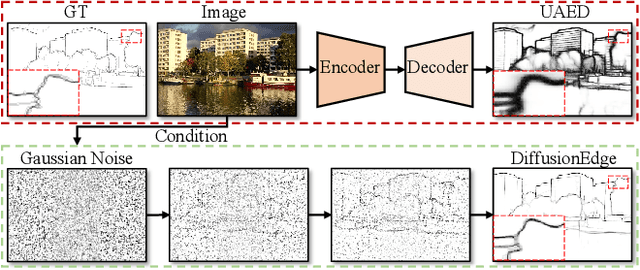

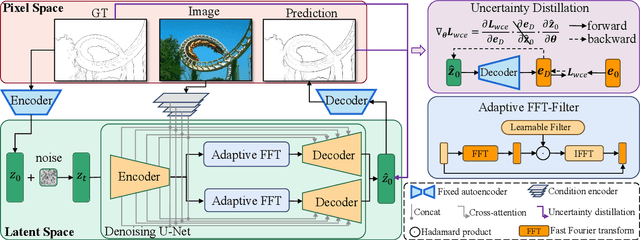
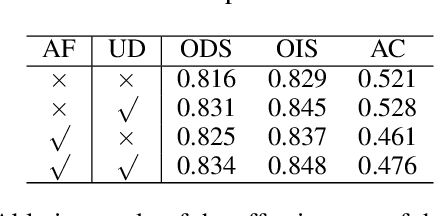
Abstract:Limited by the encoder-decoder architecture, learning-based edge detectors usually have difficulty predicting edge maps that satisfy both correctness and crispness. With the recent success of the diffusion probabilistic model (DPM), we found it is especially suitable for accurate and crisp edge detection since the denoising process is directly applied to the original image size. Therefore, we propose the first diffusion model for the task of general edge detection, which we call DiffusionEdge. To avoid expensive computational resources while retaining the final performance, we apply DPM in the latent space and enable the classic cross-entropy loss which is uncertainty-aware in pixel level to directly optimize the parameters in latent space in a distillation manner. We also adopt a decoupled architecture to speed up the denoising process and propose a corresponding adaptive Fourier filter to adjust the latent features of specific frequencies. With all the technical designs, DiffusionEdge can be stably trained with limited resources, predicting crisp and accurate edge maps with much fewer augmentation strategies. Extensive experiments on four edge detection benchmarks demonstrate the superiority of DiffusionEdge both in correctness and crispness. On the NYUDv2 dataset, compared to the second best, we increase the ODS, OIS (without post-processing) and AC by 30.2%, 28.1% and 65.1%, respectively. Code: https://github.com/GuHuangAI/DiffusionEdge.
Delving into Crispness: Guided Label Refinement for Crisp Edge Detection
Jun 27, 2023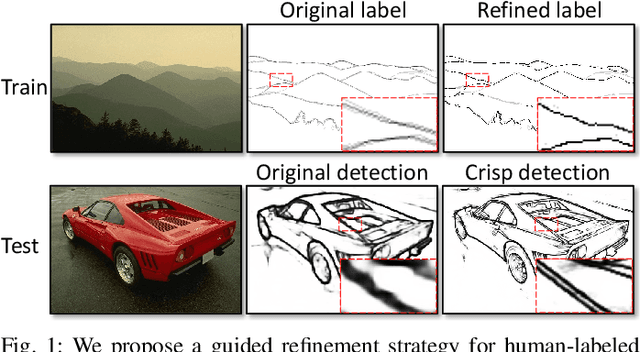
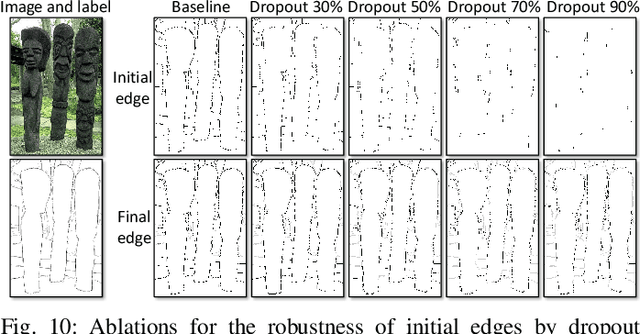
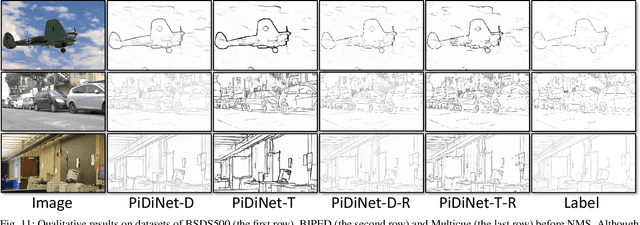
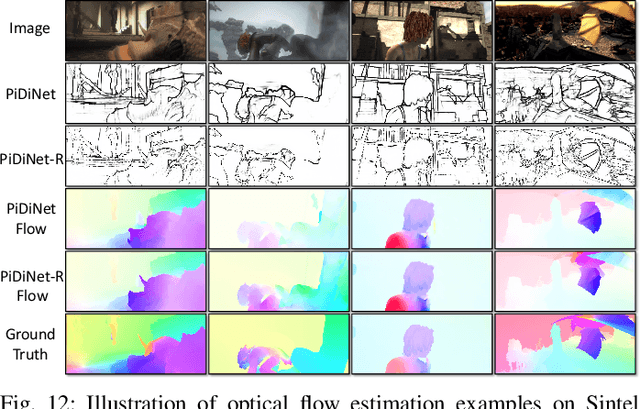
Abstract:Learning-based edge detection usually suffers from predicting thick edges. Through extensive quantitative study with a new edge crispness measure, we find that noisy human-labeled edges are the main cause of thick predictions. Based on this observation, we advocate that more attention should be paid on label quality than on model design to achieve crisp edge detection. To this end, we propose an effective Canny-guided refinement of human-labeled edges whose result can be used to train crisp edge detectors. Essentially, it seeks for a subset of over-detected Canny edges that best align human labels. We show that several existing edge detectors can be turned into a crisp edge detector through training on our refined edge maps. Experiments demonstrate that deep models trained with refined edges achieve significant performance boost of crispness from 17.4% to 30.6%. With the PiDiNet backbone, our method improves ODS and OIS by 12.2% and 12.6% on the Multicue dataset, respectively, without relying on non-maximal suppression. We further conduct experiments and show the superiority of our crisp edge detection for optical flow estimation and image segmentation.
NEF: Neural Edge Fields for 3D Parametric Curve Reconstruction from Multi-view Images
Mar 16, 2023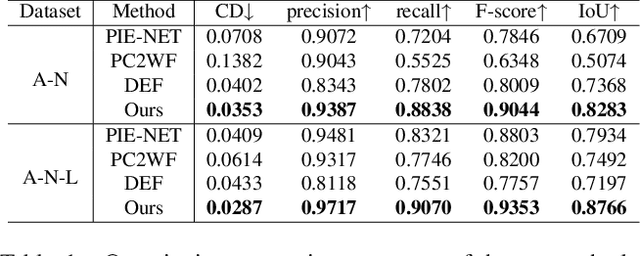
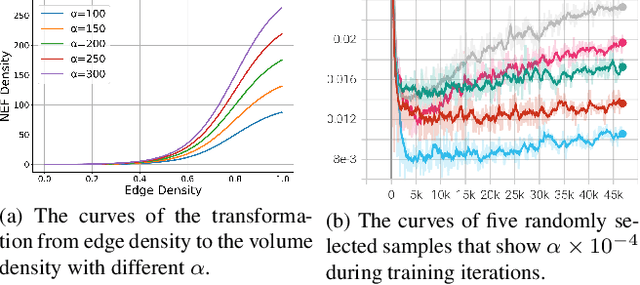


Abstract:We study the problem of reconstructing 3D feature curves of an object from a set of calibrated multi-view images. To do so, we learn a neural implicit field representing the density distribution of 3D edges which we refer to as Neural Edge Field (NEF). Inspired by NeRF, NEF is optimized with a view-based rendering loss where a 2D edge map is rendered at a given view and is compared to the ground-truth edge map extracted from the image of that view. The rendering-based differentiable optimization of NEF fully exploits 2D edge detection, without needing a supervision of 3D edges, a 3D geometric operator or cross-view edge correspondence. Several technical designs are devised to ensure learning a range-limited and view-independent NEF for robust edge extraction. The final parametric 3D curves are extracted from NEF with an iterative optimization method. On our benchmark with synthetic data, we demonstrate that NEF outperforms existing state-of-the-art methods on all metrics. Project page: https://yunfan1202.github.io/NEF/.
Learning Accurate Template Matching with Differentiable Coarse-to-Fine Correspondence Refinement
Mar 15, 2023Abstract:Template matching is a fundamental task in computer vision and has been studied for decades. It plays an essential role in manufacturing industry for estimating the poses of different parts, facilitating downstream tasks such as robotic grasping. Existing methods fail when the template and source images have different modalities, cluttered backgrounds or weak textures. They also rarely consider geometric transformations via homographies, which commonly exist even for planar industrial parts. To tackle the challenges, we propose an accurate template matching method based on differentiable coarse-to-fine correspondence refinement. We use an edge-aware module to overcome the domain gap between the mask template and the grayscale image, allowing robust matching. An initial warp is estimated using coarse correspondences based on novel structure-aware information provided by transformers. This initial alignment is passed to a refinement network using references and aligned images to obtain sub-pixel level correspondences which are used to give the final geometric transformation. Extensive evaluation shows that our method is significantly better than state-of-the-art methods and baselines, providing good generalization ability and visually plausible results even on unseen real data.
STEdge: Self-training Edge Detection with Multi-layer Teaching and Regularization
Jan 13, 2022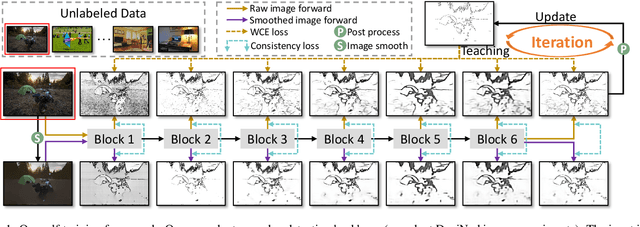
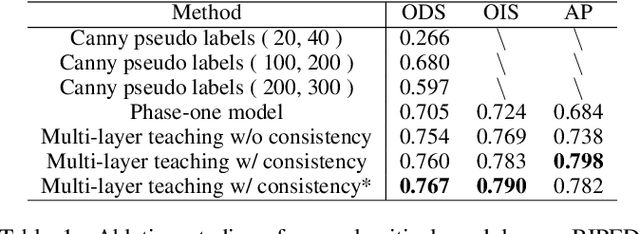
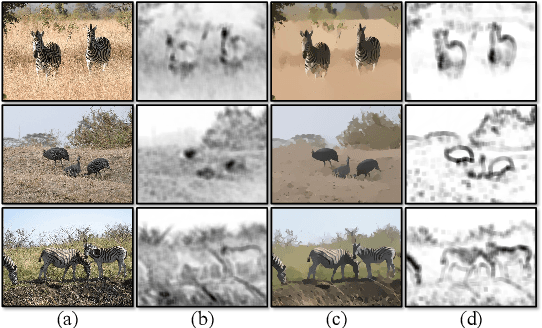
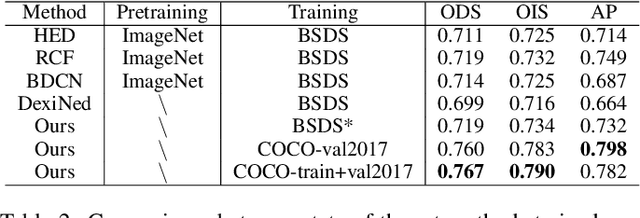
Abstract:Learning-based edge detection has hereunto been strongly supervised with pixel-wise annotations which are tedious to obtain manually. We study the problem of self-training edge detection, leveraging the untapped wealth of large-scale unlabeled image datasets. We design a self-supervised framework with multi-layer regularization and self-teaching. In particular, we impose a consistency regularization which enforces the outputs from each of the multiple layers to be consistent for the input image and its perturbed counterpart. We adopt L0-smoothing as the 'perturbation' to encourage edge prediction lying on salient boundaries following the cluster assumption in self-supervised learning. Meanwhile, the network is trained with multi-layer supervision by pseudo labels which are initialized with Canny edges and then iteratively refined by the network as the training proceeds. The regularization and self-teaching together attain a good balance of precision and recall, leading to a significant performance boost over supervised methods, with lightweight refinement on the target dataset. Furthermore, our method demonstrates strong cross-dataset generality. For example, it attains 4.8% improvement for ODS and 5.8% for OIS when tested on the unseen BIPED dataset, compared to the state-of-the-art methods.
 Add to Chrome
Add to Chrome Add to Firefox
Add to Firefox Add to Edge
Add to Edge